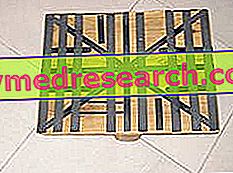Premise
Thyroid symptoms is an improper way to define the symptoms and signs of the pathologies that affect the thyroid gland.

Before proceeding with the list of the various symptoms, it is useful to briefly review what these diseases are and what they are characterized for:
- Hyperthyroidism . It is the direct result of an overactive thyroid that produces excess thyroid hormones, even when there is really no need for it.
In other words, there is hyperthyroidism when the thyroid gland produces a quantity of thyroid hormones higher than the body's needs.
- Hypothyroidism . It is the exact opposite of hyperthyroidism. Therefore, it is the direct consequence of a thyroid that is not very active and does not produce a quantity of thyroid hormones suitable for satisfying the body's needs.
- The goiter . It is the generalized pathological enlargement of the thyroid. Its onset can be associated with various problems, including the aforementioned hyperthyroidism and hypothyroidism.
- Thyroiditis . It is inflammation of the thyroid. It often has an autoimmune origin.
- The thyroid nodules . They are anomalous protuberances of the thyroid gland, generally well delimited and circumscribed, having more often a benign than malignant nature.
- Thyroid cancer . It is the malignant thyroid tumor and represents a major cause of thyroidectomy, which is the thyroid removal surgery.
Perhaps readers don't know that ...
According to a survey by the World Health Organization, around one billion people with a disease or thyroid dysfunction worldwide.
Symptoms Hyperthyroidism
To learn more, read: Symptoms Hyperthyroidism "
The presence of an excess of circulating thyroid hormones - index of hyperthyroidism - induces various changes:
- increases cardiac activity and oxygen consumption (the second derives from the first),
- promotes elevation of basal body temperature,
- increases the catabolic activity of metabolism
- alters the balance of the nervous system .
In the individual concerned, these changes are responsible for:
- Decreased body weight, despite an increase in appetite and introduced food;
- Excessive sweating, warm and velvety skin, and high temperature intolerance;
- Increased heart rate, arrhythmias, palpitations, hypertension and left ventricular hypertrophy;
- Anxiety, nervousness, restlessness, mental fatigue and insomnia;
- Shortness of breath, fatigue (muscle weakness), increased respiratory rate and hand tremors;
- Graves ophthalmopathy (see also Graves' disease or Basedow's disease); this involves protruding eyes, puffy red eyes, eye pain, sensitivity to light, double vision and reduction of ocular motility;
- Brittle, fine and thin hair;
- Fall in fertility and sexual desire;
- Menstrual cycle abnormalities (reduced or absent flows), in women, and gynecomastia, in men;
- Accelerated intestinal transit, accompanied by diarrhea;
- Thyroid enlargement (goiter);
- Behavioral disorders and learning difficulties in children.
Curiosity about hyperthyroidism
Hyperthyroidism is one of the most common endocrine-metabolic disorders, along with diabetes.
It can occur at any age; however, it is particularly common among women aged 20-50 and women over the age of 60.
According to some statistical surveys, in the United States, it would affect 1.2% of the population and would result from Graves' disease in as many as 50-80% of cases.
In Italy, it would affect 1.2-2% of the population and would have an incidence on women of at least 3-4 times more than men.
Hypothyroidism symptoms
To learn more, read: Symptoms Hypothyroidism "

In adult subjects, the consequences of hypothyroidism are decidedly less profound, compared to the previous circumstances, but still important and evident; normally, they consist of:
- Dry skin and thin and thin hair;
- Physical fatigue and chronic muscle weakness (asthenia);
- Narrow eyelids and rhymes, scarce eyebrows, half-open mouth and swollen tongue. These signs give the face of the patient with hypothyroidism the unmistakable and unintelligent aspect of the " mixed- facial facies ";
- Cold skin and intolerance at low temperatures;
- Drowsiness, lethargy, depression and slowing of ideational processes;
- Constipation, increased body weight, swelling of the face, paleness, anemia, hoarseness and lowering of the tone of the voice;
- Memory deficit;
- Hearing loss;
- Abundant menstrual flows (menorrhagia);
- Muscle cramps, joint stiffness and joint swelling;
- Bradycardia (reduction in heart rate), reduction in the contractile force of the heart and vasoconstriction;
- Increased levels of low-density lipoprotein (LDL) and serum triglycerides, resulting in a significant increase in the risk of coronary heart disease.
Curiosity about hypothyroidism
It is estimated that hypothyroidism affects an average of 0.5-1% of the population, with a clear prevalence in females and people of advanced age.
The most widespread form of hypothyroidism is primitive hypothyroidism, which is hypothyroidism dependent on a problem with the thyroid.
Hypothyroidism has a strong association with two fairly well known genetic diseases: Down syndrome and Turner syndrome (an exclusive disease of the female sex).
Goiter Symptoms
To learn more, read: Gozzo Symptoms »
There are different degrees of goiter:
- diffuse goiter, if there is a total involvement of the thyroid;
- multinodular goiter, if there is an involvement of several areas of the thyroid, but not total
- uninodular goiter, if there is extremely limited involvement of the thyroid.
Depending on the degree of goiter, the latter can cause:
- Difficulty in swallowing ( dysphagia ), due to a compression and / or deviation of the esophagus;
- Difficulty breathing ( dyspnea ), following a compression and / or deviation of the trachea;
- Difficulty in sound emission ( dysphonia ), resulting in a compression and / or deformation of the larynx;
- Headache ;
- Exophthalmos (protrusion pathology of the eyeballs).
When the goiter is accompanied by hypothyroidism or hyperthyroidism, the symptomatological picture is enriched by the symptoms and signs that characterize these two thyroid dysfunctions described above.
Short revision of the thyroid
The thyroid is an unequal endocrine gland, located in the anterior region of the neck, at the base of the throat.

- Body metabolism (for example, affects oxygen consumption; controls the synthesis and degradation of cholesterol; stimulates lipolysis and lipogenesis; increases glycogenolysis and gluconeogenesis, etc.);
- Skeletal and cerebral development, starting from fetal life;
- Protein synthesis;
- The development of the skin, the hair apparatus and the genital organs;
- The heartbeat;
- Body temperature;
- The hematopoiesis.
Thyroiditis symptoms
To learn more, read: Thyroiditis Symptoms "
There are various types of thyroiditis .
The most well-known and widespread type of thyroiditis is, without doubt, Hashimoto's thyroiditis, an autoimmune disease; Hashimoto's thyroiditis is responsible, in the first instance (that is, at the beginning), for a symptomatology that is superimposable to that of hyperthyroidism, and, secondarily (in a more advanced phase), of the symptoms and signs typical of hypothyroidism .
Other important types of thyroiditis are:
- Postpartum thyroiditis, whose symptoms are initially those of hyperthyroidism and, at a later stage, those of hypothyroidism;
- Subacute thyroiditis, which causes the same symptoms as hyperthyroidism;
- Acute thyroiditis, which causes the same symptoms as hypothyroidism.
Curiosity about Hashimoto's thyroiditis
Hashimoto's thyroiditis is the most common type of thyroiditis in the Western world.
In the United States, it affects as many as 14 million people, mostly women; in Italy, it affects 5-15% of women and 1-5% of men.
In addition to covering mainly women (the ratio of sick women to sick men is 5-10: 1), it is more common among adults: its occurrence during the second decade of age concerns 1-2% of the population, while its onset between 50 and 60 years affects 3-4% of people.
Individuals at particular risk of Hashimoto's thyroiditis are those who suffer from other autoimmune diseases, such as celiac disease, Addison's disease, type I diabetes mellitus, rheumatoid arthritis, etc.
Symptoms Thyroid Nodules
To learn more, read: Thyroid Nodule Symptoms "
In most cases, thyroid nodules are asymptomatic, meaning they do not cause any symptoms.
However, if they occupy an uncomfortable position, they are large or appear in multiple mode, they are potentially capable of causing symptoms such as:
- Discomfort and, at times, real pain, where they reside;
- Large thyroid, evidenced by a swelling on the neck;
- Difficulty in swallowing due to the compression exerted on the esophagus;
- Hoarseness;
- Breathing problems, due to compression exerting tracheal damage.

Frequently asked questions about thyroid nodules
Q: Is there a way to notice the presence of thyroid nodules?
A: If superficial or large, and not particularly located in depth, the thyroid nodules can be identified by palpation of the thyroid, even by an inexperienced hand.
Q: What is the probability that a thyroid nodule evolves into a thyroid cancer?
R: Statistics in hand, the malignant evolution of a benign thyroid nodule concerns only 5-10% of individuals with one of these anomalous protuberances, so it is quite rare.
Thyroid Cancer Symptoms
To learn more, read: Thyroid Cancer Symptoms "
Asymptomatic in the early stages, thyroid cancer may emerge at a later stage to:
- The enlargement of the laterocervical lymph nodes;
- The appearance of hoarseness associated with the presence of goiter;
- The rapid growth of a thyroid nodule, representing in fact the malignant tumor;
- The hard consistency and poor mobility of the aforementioned thyroid nodule;
- Alterations of the voice;
- Symptoms of hypothyroidism.
Curiosity on thyroid cancer
Thyroid cancer mainly affects people between the ages of 20 and 50 and women.
According to some statistical surveys, in Italy it would represent 1-2% of all malignant tumors and would affect about 9, 000 people annually.



